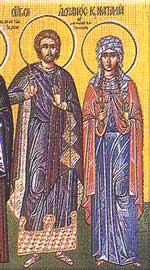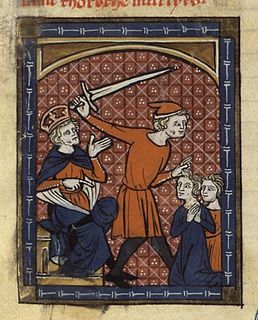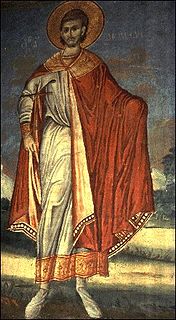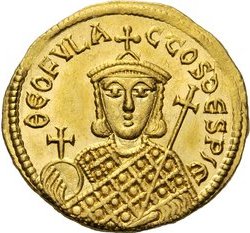
Adrian of Nicomedia or Saint Adrian was a Herculian Guard of the Roman Emperor Galerius Maximian. After becoming a convert to Christianity with his wife Natalia, Adrian was martyred at Nicomedia in Turkey. Hadrian was the chief military saint of Northern Europe for many ages, second only to Saint George, and is much revered in Flanders, Germany and the north of France.
Theophylact Lekapenos was Ecumenical Patriarch of Constantinople from 2 February 933 to his death in 956.

Nicomedia was an ancient Greek city located in what is now Turkey. In 286 Nicomedia became the eastern and most senior capital city of the Roman Empire, a status which the city maintained during the Tetrarchy system (293–324).

Paul I or Paulus I or Saint Paul the Confessor, was the sixth bishop of Constantinople, elected first in 337 AD. Paul became involved in the Arian controversy which drew in the Emperor of the West, Constans, and his counterpart in the East, his brother Constantius II. Paul was installed and deposed three times from the See of Constantinople between 337 and 351. He was murdered by strangulation during his third and final exile in Cappadocia. His feast day is on November 6.

Theophylact was a Byzantine archbishop of Ohrid and commentator on the Bible.

October 1 - Eastern Orthodox liturgical calendar - October 3

Saint Pantaleon, counted in the West among the late-medieval Fourteen Holy Helpers and in the East as one of the Holy Unmercenary Healers, was a martyr of Nicomedia in Bithynia during the Diocletianic Persecution of 305 AD.

Anthimus of Nicomedia, was the bishop of Nicomedia in Bithynia, where he was beheaded during a persecution of Christians, traditionally placed under Diocletian, in which "rivers of blood" flowed.

Saint Gorgonius of Nicomedia was a Christian martyr, part of the group Gorgonius, Peter Cubicularius and Dorotheus, who died in 304 AD at Nicomedia during the persecution of Emperor Diocletian.
Theophylact or Theophylactus may refer to:
Theophylact Simocatta was an early seventh-century Byzantine historiographer, arguably ranking as the last historian of Late Antiquity, writing in the time of Heraclius about the late Emperor Maurice (582–602).

Tryphon was a 10th-century Patriarch of Constantinople. He is venerated as a saint in the Eastern Orthodox Church.

Saints Cyprian and Justina are honored in the Catholic Church, Eastern Orthodox Church and Oriental Orthodoxy as Christians of Antioch, who in 304, during the persecution of Diocletian, suffered martyrdom at Nicomedia on September 26. According to Roman Catholic sources, no Bishop of Antioch bore the name of Cyprian.

Saint Diomedes (Diomede) of Tarsus is venerated as a Greek Christian saint and martyr, one of the Holy Unmercenaries.

The 20,000 Martyrs of Nicomedia refers to victims of persecution of Christians in Nicomedia, Bithynia by the Roman Emperors Diocletian and Maximian in the early 4th century AD.
Michael of Synnada or Michael the Confessor was a metropolitan bishop of Synnada from 784/7 to 815. He represented Byzantium in diplomatic missions to Harun al-Rashid and Charlemagne. He was exiled by Emperor Leo V the Armenian because of his opposition to iconoclasm, and died on 23 May 826. He is honoured as a saint by the Orthodox and Roman Catholic churches, his feast day is May 23.

Stephen II of Amasea, was the Ecumenical Patriarch of Constantinople from 29 June 925 to 18 July 928. He appears to have been appointed to the post by Romanos I Lekapenos after the death of Nicholas I as a stop-gap until Romanos's own son, Theophylact, was old enough to assume the post. Steven Runciman calls him a "deliberate nonentity". He is a saint, commemorated on July 18.

Prochorus was one of the Seven Deacons chosen to care for the poor of the Christian community in Jerusalem. According to later tradition he was also one of the Seventy Disciples sent out by Jesus in Luke 10.

Theophylact or Theophylaktos was the eldest son of the Byzantine emperor Michael I Rhangabe and grandson, on his mother's side, of Nikephoros I. He was junior co-emperor alongside his father for the duration of the latter's reign, and was tonsured, castrated, and exiled to Plate Island after his overthrow, under the monastic name Eustratius.
Sergios Niketiates was a senior Byzantine official and member of the Amorian dynasty. He is celebrated as a saint by the Orthodox Church on 28 June for his role in the restoration of the veneration of icons.















